This post is about how to build a growth-focused SaaS SEO strategy.
But first, a little story…
Six weeks ago, I was struggling.
I was trying to art direct some updates to our website. (Cue 🙄)
I’m not a designer–at all.
So, I went to Google.
“How to do web design for non-designers,” I searched.
I scanned slowly down the page (well, not the whole page–probably just the first 3 or 4 results) until I landed on a link that looked promising.
“Web design without a web designer?,” it read.
Click.
Reading through the article, I discovered that the problem I was facing was a common one. Many growing agencies lack specialized talent or tools for all of their projects at one point or another. In this case, a prototyping software might be just what I was looking for in order to visualize my design ideas and communicate them to the team.
Oh, and–imagine that–Figma, who published the blog, happens to sell this exact software. I clicked from the blog post onto the homepage to learn more.
As I scanned the page, reading about features and benefits, a realization slowly crept into my brain.
I had entered the top of their funnel.
Although I spend a big part of my life researching and mapping out this process from the perspective of our clients and their businesses, the act of doing it myself feels so obvious and natural that my own buyer journey didn’t even feel like a conscious act.
I was just looking for information about a problem.
But this initial search led me to a solution–Figma. From there, I dug into the space further, comparing their tool to competitors, understanding how the software actually worked (could I use it with no design experience?) I learned a lot and ultimately decided to pull the trigger. I am now a happy user of Figma, our site got a small design refresh, and I’m already planning the next iteration.
This exact story happens millions of times, every single day.
And, just like in my case, SaaS companies that have a strong SEO strategy appear higher and more frequently in the Google results. This means they generate more targeted traffic from users who are in an active buying cycle (even if they don’t realize it), which they can then convert into leads and customers.
The SaaS companies that I found in my search didn’t show up on Google magically. They invested in a smart SEO strategy. They built problem-focused articles that addressed my pain and introduced me to a solution. They optimized their website to rank for the most relevant search terms. They earned backlinks that helped them outrank their competitors.
All of these factors helped to put them front and center in my buying journey.
But, more importantly, it helps put them in front of all of the other buyers who, like me, turn to Google every day to find information and solutions.
That’s the power of SEO for SaaS companies.
The right SEO strategy is critical to building an inbound acquisition model that scales over time and generates a predictable source of leads and traffic.
Content Marketing + SEO for SaaS Businesses
Before we get too far into the weeds, let’s just do a quick primer on the relationship between SEO and content marketing. Throughout this article, I’ll refer to both–and almost interchangeably.
These terms aren’t really the same, but they go hand-in-hand.
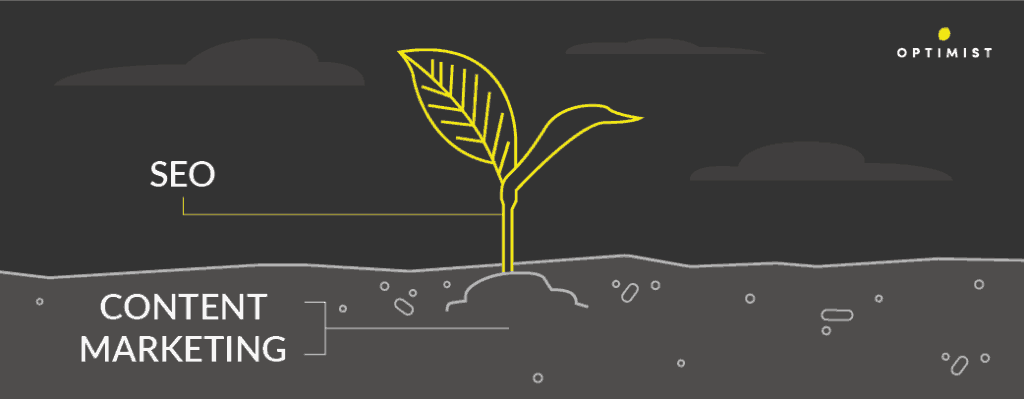
Free Bonus Content
Get the full list of strategies, tactics, and tools you need to plan and execute a content marketing strategy that will help you achieve explosive growth.
No tricks, gimmicks, or bullshit.
Click below for the Complete Content & SEO Growth Collection
Content marketing drives SEO by providing the targeted content, keywords, and links that you need to drive growth through search.
It’s like the soil that you need to grow a healthy SEO strategy.
So, when you invest in an SEO strategy for your SaaS company, here’s how it should work:
- Identify the pain points or JTBD that your product solves
- Build a top-of-funnel keyword strategy based on these queries that target buyers at the beginning of their journey
- Research product keywords that map to your homepage, feature pages, solution pages, and integrations
- Build comparison content that helps you stand out against both direct and indirect competitors based on the initial JTBD
- Create a content map and plan
- Dial in your on-page and technical SEO
- Invest in linkbuilding to help improve your rankings versus competitors
That’s a lot of steps–and SEO is a big investment.
But, is it worth it? I’d say so. Let’s look at why I think SEO is such an important point of focus for SaaS companies in particular.
Why SaaS Companies Should Invest in SEO
Look, there are a lot of channels and strategies out there for driving SaaS growth.
Facebook, Reddit, podcasts, email, chatbots–they all want a piece of your marketing spend.
So what makes SEO special?
Why should you invest in this huge initiative that won’t pay off for months (or years!) when you could sling out 20 new Facebook ads and see immediate traffic and users today?
The short answer is simple: Content marketing and SEO are the foundation for a sustainable, predictable, and scalable SaaS growth strategy.
Look at some of the most successful SaaS companies in the world and they have all invested heavily in content-driven growth. ZenDesk, Salesforce, Drift, Intercom, Buffer, Asana, InVision (and Figma!)–they’re all-in on content marketing and SEO.
That’s not to say that they invested only in content marketing. Most of these companies have a varied growth strategy, but content and SEO is the engine that drives it forward.
Let me expound on this a bit further by diving into 3 key reasons why SEO is a critical investment for SaaS companies that want to scale quickly.
Reason #1: SEO Scales Exponentially
In a world full of marketing channels and acquisition strategies, inbound marketing and SEO are generally among the most scalable and predictable approaches to SaaS growth.
The reason for this is simple.
The results that you generate from SEO will compound over time. With a well-executed SEO strategy, you’ll see exponential growth in targeted traffic, which can then be turned into leads and users.

Search traffic is generally predictable.
As a content marketing agency, we’ve seen this time and time again. When we work with SaaS clients, we’re able to build compounding, exponential growth. Our strategy is to create valuable content, focus a core set of targeted keywords, build high-authority links, and improve the search rankings of key product marketing pages.
While the exact number of people who search for a given query will vary from day to day, you can pretty accurately predict how much traffic you’ll receive if you rank #1 for a search term like “content marketing software.”
Reason #2: SEO reduces the dependence on paid marketing
For many SaaS companies, paid acquisition can become a deadly addiction.
While paid channels can be effective, as a SaaS company enters the growth phase, it makes sense to pivot away from pure paid acquisition to more long-term, scalable strategies.
In almost all cases, the cost to acquire a user through a paid channel will go up over time. Your costs will rise as you exhaust the audiences that are most likely to convert, new competition enters the market, and more advertisers bid for the same inventory through paid channels.
And, of course, reducing your spend is not an option.
With paid acquisition, if you stop spending, you stop growing.
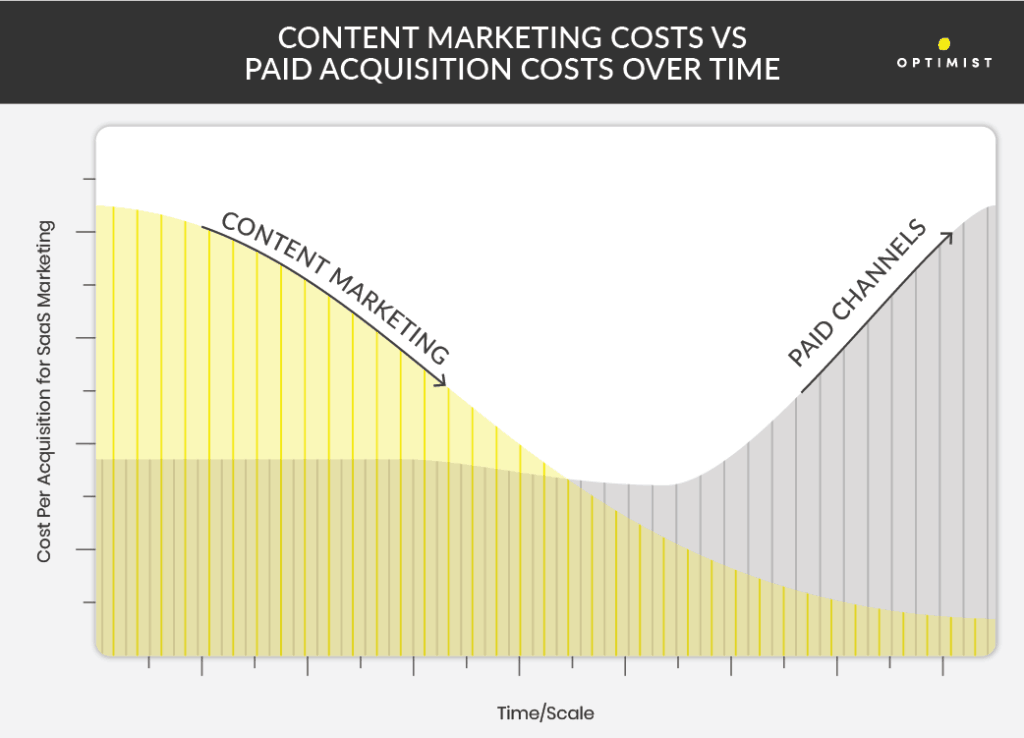
SEO and content marketing work in exactly the opposite way.
The initial investment will be slow to yield measurable results. In most cases, it will take several months to see a clear pattern of growth and real traction with an inbound marketing strategy. But that growth compounds over time–growing steadily and becoming a long-term asset.
While SEO is not maintenance-free, the marginal cost to acquire a new user through organic traffic should decrease over time as your inbound traffic grows and you recognize the value of the traffic on a compounding basis.
A blog post published today has a fixed cost, but it could generate traffic and leads for years to come, shrinking the calculated CPA with each new inquiry.
Because of this, SEO is a smart long-term growth strategy for companies that need to wean themselves off of paid channels as their primary driver for new sign ups or users.
Reason #3: SEO powers all other acquisition strategies
Like most marketing strategies and channels, SEO cannot function in a vacuum.
Yes, investing in content, keywords, and links will yield a large increase in targeted, organic traffic over time. But, as you know, traffic to your website does not equal sign ups or revenue. Beyond SEO, you need additional marketing strategies to capture, nurture, and convert that traffic into actual users.
The upside here is that SEO can “feed the machine” so to speak–providing you with a constant stream of persona-qualified traffic that fill up your marketing funnel.
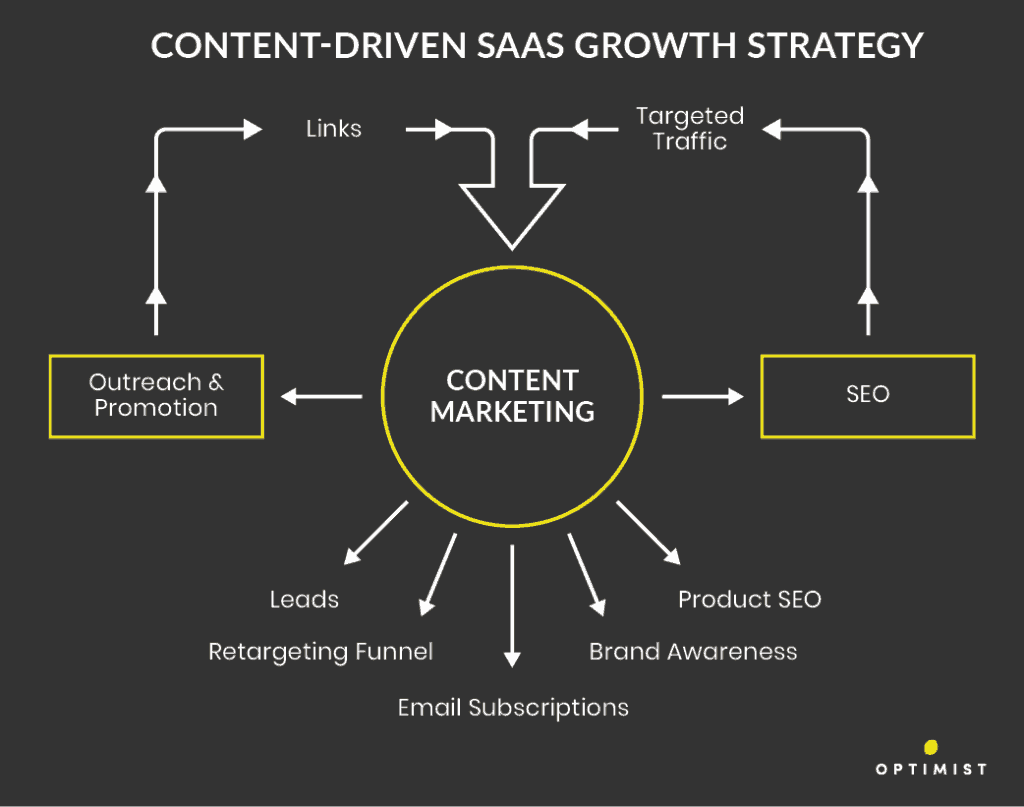
This is what makes SEO such a critical component for SaaS marketing. The traffic you generate powers other channels and strategies like driving email subscribers and filling your retargeting funnel.
With this all in mind, let’s dive right into how you can pursue and execute a successful SEO strategy that will, in fact, drive the growth in traffic and leads that you’re hoping to achieve.
Mapping your SEO Strategy
to the SaaS Marketing Funnel
Creating a successful SaaS SEO strategy doesn’t happen by just collecting an arbitrary list of keywords.
It starts with the buyer’s journey.
That is, understanding the steps that a potential user takes from the beginning of their research process through to the point where they decide to sign up for your SaaS product. (Note: In this case, we are referring to the buyer’s journey only up to the point that they sign up or begin a trial.)
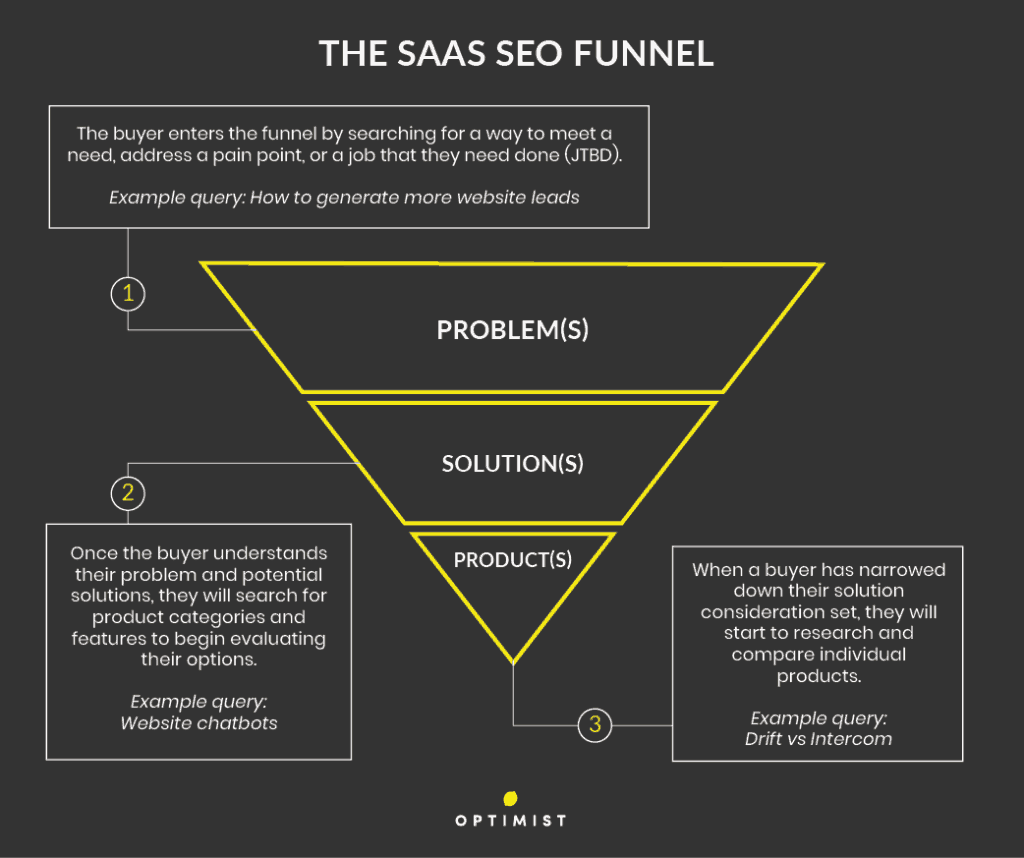
While we typically think of this as being a series of stages or a funnel, the buyer rarely experiences a linear journey from top to bottom.
Because of this, you can’t assume that each buyer will come to your site at the top of the funnel and then you can use email or nurturing to move them through each step. This means developing a robust keyword and SEO strategy that extends beyond the top of the funnel into the consideration and purchase phases.
Let’s step through each stage of the funnel and how you should incorporate it into your SEO strategy.
Top of the Funnel SEO:
Attracting Prospective SaaS Buyers
Your buyer has a problem.
They’re probably not sure exactly how to solve it. Hell, they may not even know how to articulate it. But they have an itch. Some part of their personal or professional life could be better if they could just find the right solution.
This is their pain.
Many SaaS buyer journeys begin here. Maybe your customer is looking to improve their customer service efficiency or they need a way to get their clients to pay invoices more quickly.
Where do they turn?
The same place everyone does. The same place I turned before discovering Figma.
Google.
The buyer sets out to research the pain they are feeling, try to understand it, and hopefully find a solution.
“How to get my invoices paid more quickly,” they type.
As a SaaS marketer, this is an opportunity for you to attract a potential buyer at the very beginning of their journey.
From an SEO standpoint, you can usually accomplish this by creating targeted content for the specific queries that your buyer is searching.
- “How to increase my sales win rate”
- “Keeping track of business expenses”
- “Grow my business”
In most cases, these become blog posts that serve as a simple, educational tool for your audience. They explain how the user can solve a problem or meet their need. Then, it should introduce a solution for that problem. If you’re marketing a SaaS product, then the solution is–of course–a piece of software that has a feature that meets their needs (hopefully yours!)
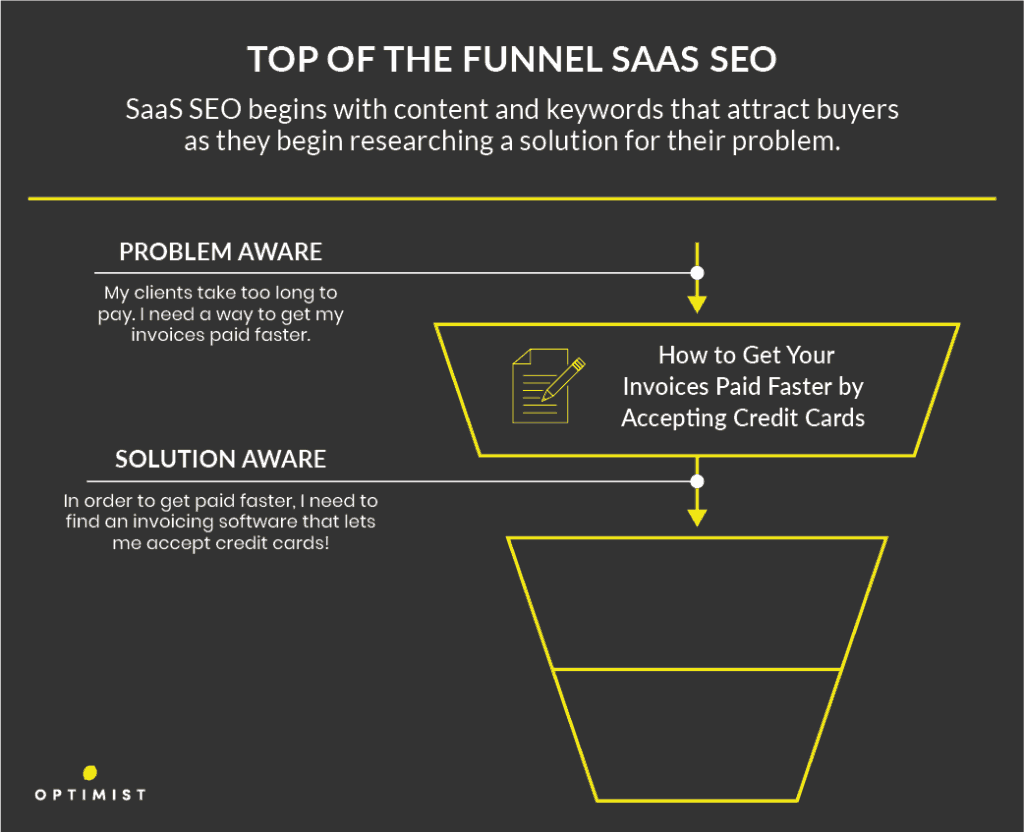
At this stage in the buyer’s journey, they are just beginning their research process.
This means that only a small percentage of the visitors (usually fewer than 1%) will come to your site, read this content, and immediately convert into a customer.
But that’s okay.
The goal that you set for this content should be to fill the top of the funnel–create a pool of prospective buyers who are entering a sales cycle and are likely to make a purchase decision in the near future.
As part of your overall SEO strategy, your goals for this content are straightforward:
- Attract targeted traffic consisting of problem-aware prospects
- Help the reader learn about how they can solve their problem
- Educate the reader on a specific solution or product category
- Capture these prospects via an email newsletter, content upgrade, or retargeting pixel
Part of your strategy here may be to immediately send the user further into the funnel by getting them to click a link to another page on your site.
That would be the middle of the funnel–the next step in the journey.
Middle of the Funnel SEO:
Putting Your SaaS Into the Buyer Consideration Set
The middle of the funnel occurs after a buyer becomes aware of a solution to their problem but before they have begun to research specific products that meet those needs.
During this stage, the buyer is creating a consideration set.
This is a list of tools, products, or services that may help them solve their initial pain. Keep in mind that the solutions your prospect is considering may not always be direct competitors with your software. It could be a completely different solution that might fix the same problem.
In the middle of the funnel, your goals should be:
- Attract solution-aware traffic
- Introduce your SaaS product to the consideration set
- Educate the buyer on integrations, workflow considerations, and general feature differentiation
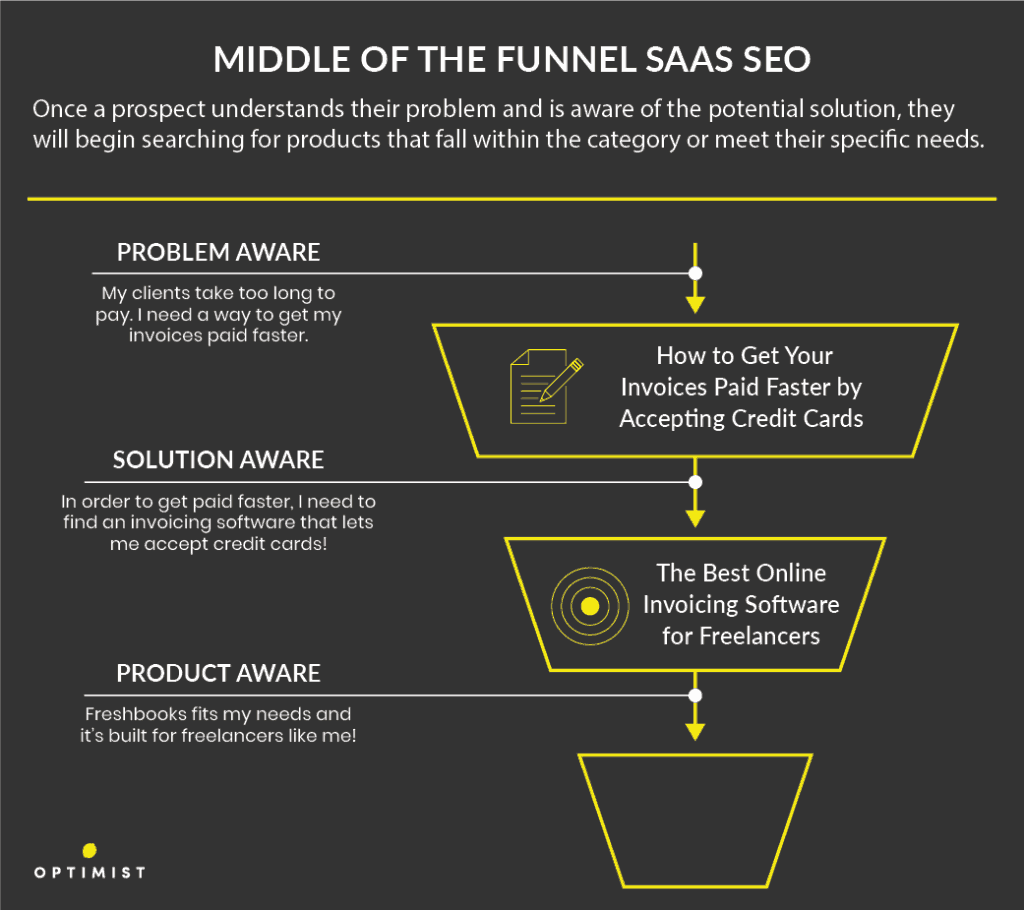
For this stage of the buyer’s journey, they are researching product categories, features, requirements, implementation, and integration information. But they’re armed with more precise language about the types of solution that they’re looking for, based on the research they did to find answers to their problem.
- “Sales enablement tool”
- “Digital signatures for Salesforce”
- “How to choose the right CRM”
Or, they’re searching for specific implementations of the solution, including integrations with other tools and software. They could also be searching for products within a category that fit their specific persona or industry.
“Accounting software for freelancers,” they might search after discovering that one way to get their invoices paid faster is to use accounting software that allows them to accept credit cards.
For SaaS companies, content and pages that attract middle of the funnel searches generally fall into one of about 6 key types.
- Product category – Your most basic searches like “help desk software”
- Product category comparison – When the buyer is comparing multiple possible solutions to their initial pain. “Help desk software vs knowledge base software”
- Solution/industry – More specific searches that identify the buyer’s persona or industry. “B2B help desk software”
- Features – Specific features that the user is looking for in a solution. “Help desk software with chatbots”
- Integrations – How the software plugs into other tools. “Help desk software with Salesforce integration”
- Implementations – Specific use cases that the user is researching. “How to route support tickets to Slack”
Keep in mind that prospective buyers can come to your website at any point in their journey.
In this case, we are examining the middle of the funnel through the lens of SEO or organic search as a channel. So, this content isn’t necessarily geared for users who are already in your funnel (via email, retargeting, etc). It’s meant for those who are landing on your site via search.
Even though the prospect has already identified a potential solution to their pain and they are actively researching tools or services, they could be landing on your website for the very first time. So, when you plan and create content that’s optimized for middle-of-the-funnel keywords, you should assume that a reader may have no familiarity at all with your company or product.
Also, keep in mind that the lower in the funnel–the further in their journey–the buyer is when they land on your website, the more likely they are to convert into an actual customer.
So these keywords will likely become both less popular (from a search volume perspective) than top of the funnel searches and also more competitive from an SEO standpoint.
This leads us to the final step: the bottom of the funnel.
Bottom of the Funnel SEO: Differentiating Your Product from Alternative Solutions
At the bottom of the funnel, the buyer is now fully aware of the problem they’re facing, the solution they will use to solve it, and likely some (or all) of the specific products that meet their needs.
In the marketing vernacular, we call these buyers product-aware. (Note: Product-aware refers to the fact that the buyer is aware of specific products that may meet their needs. That doesn’t necessarily mean they are aware of your product in particular.)
So what’s left?
Well, most buyers will compare multiple products to see how they stack up before they decide on a solution.
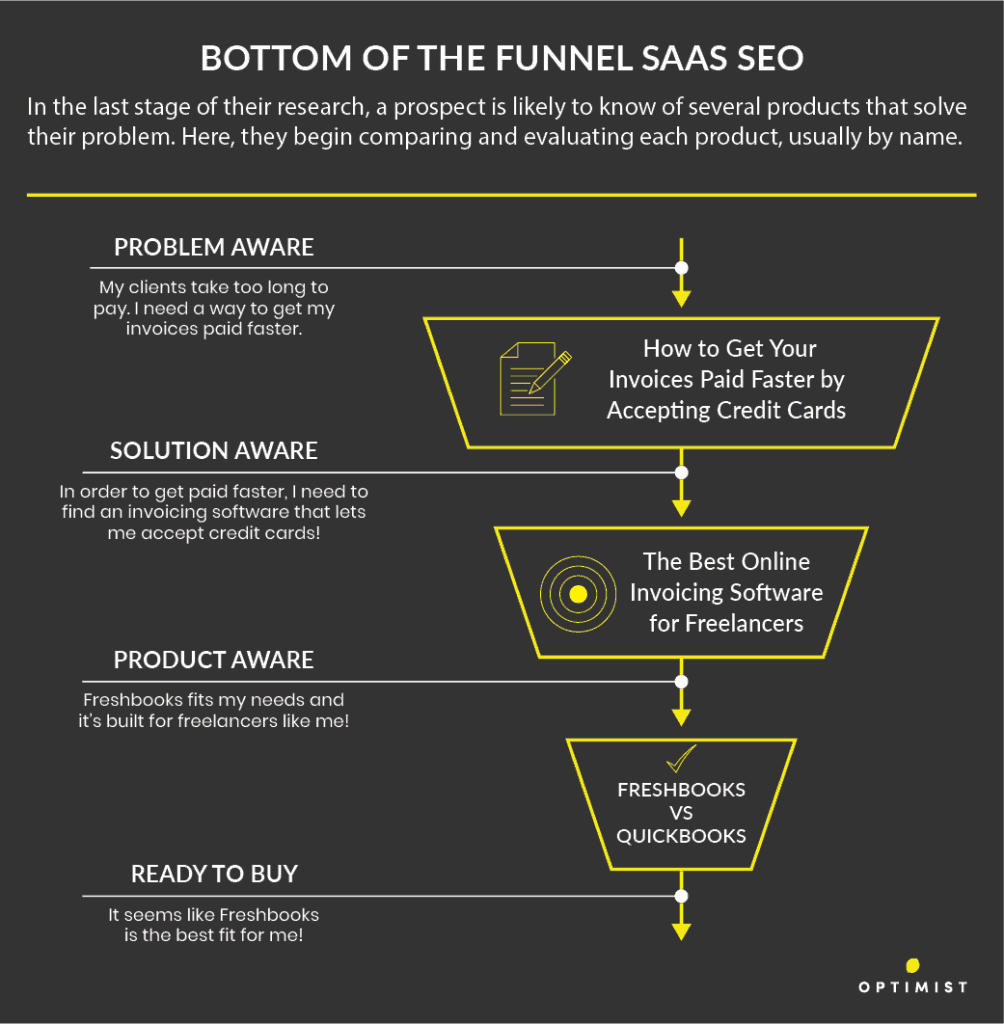
This means that if your SaaS is in the consideration set already, buyers will likely be searching for info on how your product compares to competitors (both direct and indirect).
If your product is not in consideration at this point, you also still have a chance to enter the conversation.
Here’s your goals for bottom of the funnel SEO:
- Attract product-aware traffic
- Inject your SaaS product into the consideration set (if it isn’t already)
- Highlight the key features or considerations that make your product a better fit than competitors
- Differentiate your product category (and your specific product) from alternative solutions
These keywords generally fall into a few high-level buckets:
- Comparisons (X vs Y)
- Alternatives/competitors (Y Alternatives)
You’ll need to do some keyword research and competitive analysis in order to build out a targeted SEO strategy that positions you for the searches your prospects are doing at this stage in the buying process.
Pre-Funnel SEO:
Attracting the Right Buyer Persona
Lastly, I want to touch on the idea of pre-funnel SEO.
This is an important approach that many SaaS companies use as part of their strategy. Rather than focusing only on a pool of buyers who are looking to solve a specific problem (problem-aware), this content and the associated keywords are used to attract persona-qualified traffic, even if they aren’t in the market for any specific product or service.
Think of it like a trade publication for your industry.
You’re talking to the right people, even if not everyone is interested in what you’re selling right now.
This can be especially effective for niche industries and businesses.
If there are only a few targeted keywords that qualify your traffic as being the right persona and problem-aware, or if you’re focused on generating demand in an emerging category, you can focus on pre-funnel SEO to grow your audience. Combined with other nurturing tactics, this is an effective way to drive problem awareness and generate demand.

For example, HubSpot’s content marketing strategy is extremely top heavy—they invest a lot in creating content that attracts marketers and salespeople. Not every article that they publish will map directly to a pain point that HubSpot’s software solves.
But that’s okay.
Pre-funnel keywords can be anything that are relevant to your buyer persona, even if they’re removed from your product itself. In HubSpot’s case, it’s everything from “how to set your marketing goals” to “how to hire a head of marketing.”
For them, content marketing is both an acquisition strategy and part of their brand awareness and demand generation efforts. Not every article needs to lead to direct product signups.
In advertising terms, you might think about this as serving a similar strategic function as a brand campaign.
Your goal with pre-funnel keywords:
- Attract persona-qualified traffic, even if they don’t necessarily have an immediate need for your product
- Fill your retargeting funnel
- Achieve a micro-conversion (email signup, content download, etc)
- Build an addressable audience within your target group(s)
Keyword Research for SaaS SEO
The heart of successful SEO is your keyword strategy.
In order to rank for a set of target keywords, you need to first identify those keywords and then create pages or content on your site optimized for each query.
For the sake of this guide, I’m not going to go through the entire keyword research process from scratch. Our friends Brian Dean at Backlinko and Tim Soulo over at Ahrefs have each written very thorough, tactical guides on how to conduct keyword research from scratch.
What’s important here is how you structure and think about keyword research for SaaS products specifically.
Ultimately, it goes back to the buyer’s journey.
Problem-Solution Keywords (Top of the Funnel)
To build a top of the funnel strategy, you should start with the buyer’s pain points or problems that they experience with respect to your product.
Let’s use a different real-world example to walk through this exercise together.
Drift sells some cool website chat software, along with bots and automation features.
But when a prospect begins the buying process, they often don’t set out to buy website chat software. Instead, they have a certain problem to solve, pain point to address, or “job” to be done (JTBD).

Maybe they want to accelerate their sales cycle, generate more leads from their website, or automate lead qualification.
These are all pain points or JTBD that Drift can help them solve.
The process of keyword research should begin by identifying the pain points and JTBD that your buyer is experiencing and will lead them to use your product.
Our process involves a mix of several approaches:
– JTBD framework
– Competitor analysis
– Feature/pain point mapping
For each of our clients, we go through a deep research process where we begin by understanding the customer’s initial problem and then conducting keyword research for each use case to build a strategy.
Begin at the top of the funnel by creating a problem-solution map that breaks down your product, features, and use cases into user stories (JTBD).

Each user story should present a specific problem or pain that the user feels when they first begin their buying journey. Then, you can use that pain point to uncover specific keywords that you should target at the top of the funnel.

As we work through all of the individual features and personas, we uncover a huge number of specific “jobs” that customers are hiring the product to accomplish and how they align with the features of the product.
Solution-Product Keywords (Middle of the Funnel)
Following along down the SEO funnel, we move into the middle part of the buyer’s journey.
At this stage, the prospect is looking for specific product categories and features that they have identified as a potential solution to their problem.
You want to approach this research by looking at several different types of keywords that would identify a solution-aware buyer who is searching for specific products to add to their consideration set.
- Product category keywords
- Product feature keywords
- Industry/vertical solution keywords
- Implementation/integration keywords
We go through this process in a pretty simple way.
First, we work through the various features of the product and we break them down into the features or use cases that we think a buyer may be searching for. From a high-level descriptor of the software you sell, all the way down to the individual features, using keyword data to guide the specific language choices.

Next, we identify the key industries and verticals that we serve and want to target with custom-tailored solutions pages. In Drift’s case, they emphasize the team or role rather than specific key verticals. That’s okay, too.

These become their own set of keywords (and eventually pages or content) that are optimized to capture this persona-specific or industry-specific traffic.
Lastly, we look at any key integrations that may warrant their own pages or content. We also try to identify any key implementation use cases that may have any significant search volume.
Keep in mind that during this research phase, we are beginning with a raw brainstorm.
Armed with a bunch of best guesses, we will use a tool like Ahrefs to conduct data-driven research about which keywords we should target.
While conducting this research, you should carefully consider the user intent behind the query. You can often verify that intent by conducting the search yourself and seeing which results Google sees as most relevant.
If I’m searching for “website lead generation” I am trying to solve a problem–I need a way to generate more leads.

The SERP reflects that intent.
The top results are articles, guides, and resources. They’re not product or feature pages.
On the other hand, if I search for “website lead generation software,” I have already identified that the solution to my problem and I am now looking for specific products that meet my needs.
Often, you’ll find that keywords that seem to fall into this stage of the funnel actually belong in a different part of the journey. That’s okay—the keyword may still be an important part of your overall strategy. But in order to rank, you’ll want to be sure that the content on your page aligns with the intent behind the search.
Product Comparison & Purchase Keywords (Bottom of the Funnel)
Now, we have moved onto the final phase of our keyword research process.
We want to create comparison pages that allow us to capture search traffic from buyers who are evaluating specific product solutions.
Begin this process by making a list of competitors.
This list should include direct competitors (like Intercom, in Drift’s case), but also alternative solutions to the problems we identified at the top of the funnel.

For instance, some buyers may be comparing the idea of using live chat software versus a more traditional form or exit-intent popup software. Both of these alternate solutions could do the “job” of generating more inbound leads.
Ultimately, the competitor set–the possible solutions that the user is evaluating–will depend heavily on the JTBD for that particular buyer.

Most of the bottom of the funnel keywords fall into a few key buckets:
- X vs Y
- X Alternatives / Competitors
- How to Choose the Right X Software
Using a keyword tool like Ahrefs or SEMRush is important here for helping you uncover and compare the combinations that may be applicable. It may also help you identify how prospects think about your competitor set, which is probably different from what you expect going in.
When in doubt, follow the data!
Bringing it All Together: Creating an SEO Content Map
From this process of analysis and research, you should have a big list of keywords that fall somewhere along the buyer’s journey.
So, now what?
Free Bonus Content
Get the full list of strategies, tactics, and tools you need to plan and execute a content marketing strategy that will help you achieve explosive growth.
No tricks, gimmicks, or bullshit.
Click below for the Complete Content & SEO Growth Collection
The next step is where you synthesize the data into an actionable plan that will inform everything from your site structure to landing pages, blog content, and product feature, integration, or solutions content.
In a nutshell:
- Keep your keywords segmented by funnel stage
- Within each funnel stage, parse out your list of keywords into groups or individual keywords that can be reasonably targeted with a single page (1-3 very similar keywords/variations per page)
- Create a plan or content map that shows all of the keyword groups you are planning to target and some basic details about what content should be included
- If applicable, compare your content map with your existing website/content and update or optimize pages that align with the content map
- Where there are gaps, plan to create new pages or write new content in order to target these keywords across the buyer’s journey

This becomes your tactical guide.
As I mentioned before, in order to maximize your SaaS website’s footprint in the search results, you’ll want to create new content that’s optimized for the keyword groups that you identified here.
This will give you the opportunity to capture search traffic from prospects as they progress through their buying decision.
On-Page Optimization: The Basis for Ranking
It takes a bit more than just keywords on a page to rank well.
While I’m not going to go in-depth in technical and on-site optimization in this article, Moz has a handy guide on this topic.
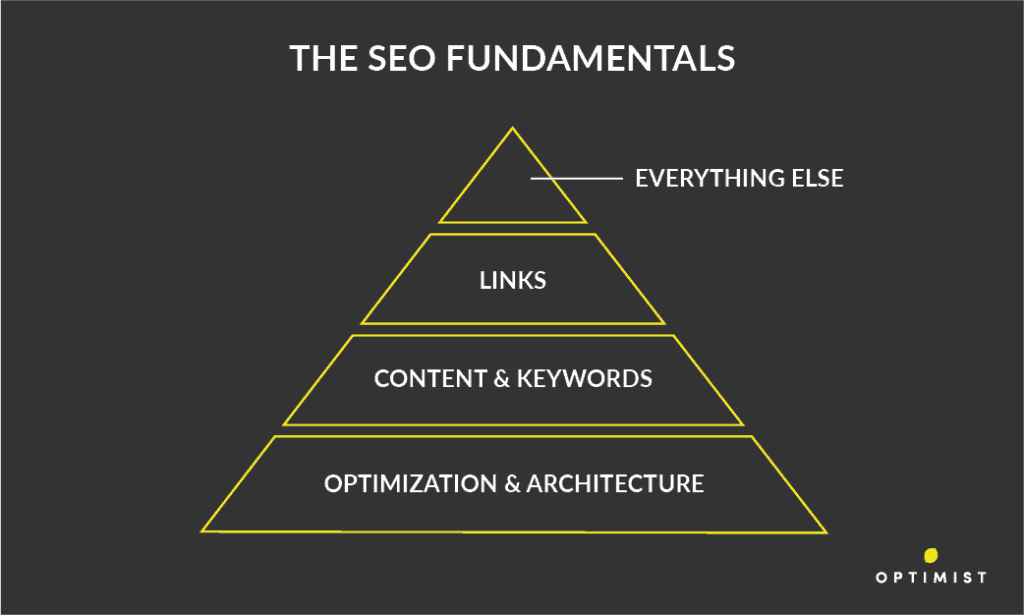
The key takeaway is that without basic, on-page optimization, your chances of ranking are pretty slim.
At the very least, you’ll want to make sure you have a few things in place:
- Optimized, unique titles for each page
- One H1 tag on every page, optimized for the target keyword
- Obvious page hierarchy, making use of H2, H3, etc tags where it makes sense for the reader
- Clean HTML and markup that make it clear which elements on your site are most important
- Intuitive site architecture that’s easy for humans to navigate and search bots to crawl and index
- No hidden content, keyword stuffing, cloaking, or other black-hat things
If you follow general best practices for on-site optimization and have a smart keyword strategy with content targeted at each stage of the funnel, you’re most of the way there.
But great content on its own isn’t enough.
Linkbuilding for SaaS SEO
Last, but certainly not least, we have a critical component for SaaS SEO.
Building links.
Most marketers cringe at the idea of asking people for links. There’s something that undignified about the whole process. So, they focus on creating great content (that’s a good start) and then hope and pray that people will find it and link to it.
But, here’s the hard truth: Content without links doesn’t rank.
No other signal correlates more strongly with high search rankings than the number and quality of backlinks pointing to your site. So, if your content doesn’t rank in the first place, how will your content be discovered in order to accrue links in a more natural way?
You need links—full stop.
And, you need to use some form of active outreach to help get the ball rolling.
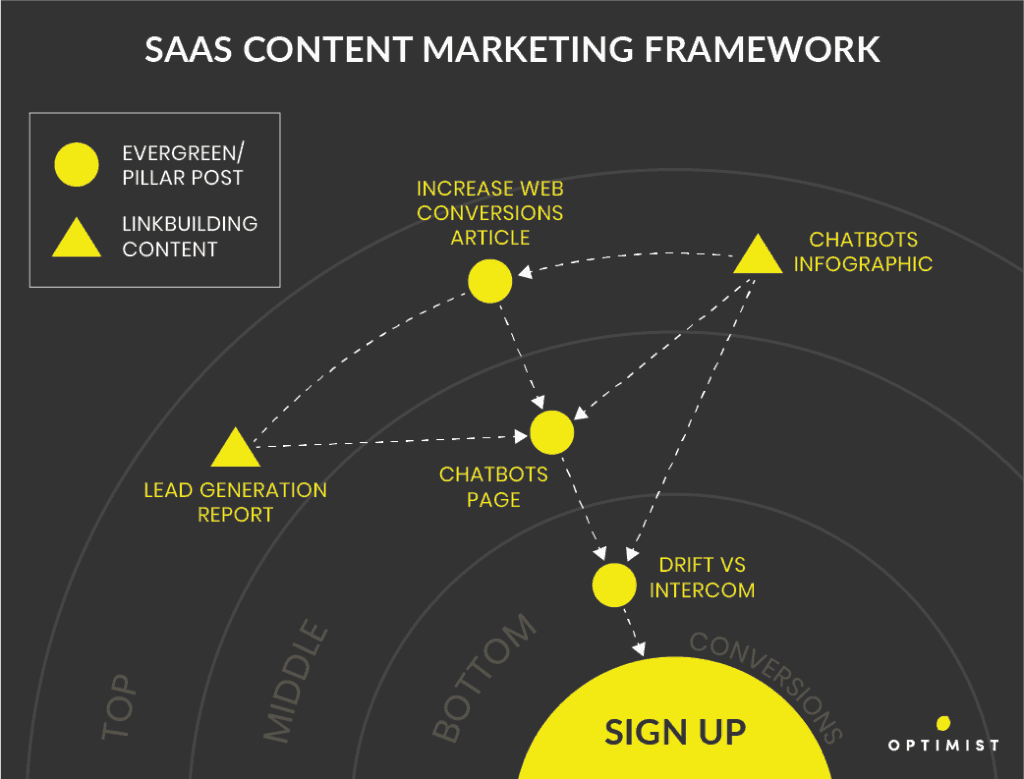
Links are the glue for this entire strategy. They help pass authority to important, but difficult-to-earn-links-for pages like your product features.
Yes, even great content–even “epic” content—will not magically rank without some smart strategy and effort to help it along the way. A big part of that strategy and effort is manual promotion and outreach that helps you build links and raise your overall domain authority.
So how do you generate links?
The short answer is simple.
- You create kick-ass content (worthy of links)
- You show it to the right people (email outreach, pitching journalists, sharing with influencers, submitting it to newsletters and roundups, etc, etc.)
Without getting into all of the nuance of exactly how you build links at scale, you should check out Alan Silvestri’s awesome post on Traffic Think Tank. They have put together a great guide that includes lots of tactical takeaways and key, replicable strategies for generating inbound links that both power SEO and drive conversions (that’s called a two-for!) Alan also wrote an awesome piece on evaluating ROI for linkbuilding. It’s worth a read as well.
The execution of this part of the strategy can look radically different depending on your business, your audience, and the broader verticals or industries that you’re operating in.
But don’t skip this part of the strategy. It’s absolutely critical. While we aren’t diving into it fully here, that doesn’t mean it’s any less important.
Connecting SEO to Your Broader SaaS Marketing Strategy
As we wrap up the process of building a successful SEO strategy for your SaaS company, I need to point out that ultimately SEO is just one channel and one strategy.
The world’s most successful SaaS companies rely on a combination of up to 7 key channels to drive traffic and leads, according to data compiled and analyzed by Mike Sonders.

And those channels most often work together.
- Organic traffic to your blog fills the retargeting funnel, which is the basis for your paid campaign
- Linkbuilding and PR efforts increase your name recognition and drive WoM signups
- PPC campaigns drive product signups, which are nurtured by email
TL;DR: SEO is important, but it’s not the whole game.
Even so, as Mike points out in his post, SEO and organic traffic is consistently the number one driver for most successful SaaS companies.
Scaling inbound, targeted traffic to your site is likely to be the engine that propels your company forward and that makes SEO the most critical strategy for attracting buyers to your site all through the funnel.
Generating a constant stream of traffic from search is a major investment that can pay off—exponentially.
Get More Kick-Ass Content From Us
Subscribe to our email list and get regular updates. No spam or BS. Just great, insightful articles.

Tyler Hakes
319.241.9302
Email Us
